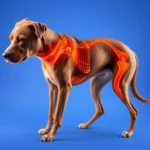
Introduction
Hypothyroidism in dogs is a condition that affects the thyroid gland, a crucial part of the endocrine system responsible for regulating metabolism and energy levels. When the thyroid gland does not produce enough thyroid hormones, it can lead to various health issues in dogs. Understanding this condition is essential for pet owners, as it can significantly impact a dog’s quality of life and overall health.
Awareness of hypothyroidism in dogs is vital for several reasons. This condition is relatively common in certain breeds and can lead to serious health implications if left untreated. Recognizing the symptoms early can lead to timely diagnosis and effective treatment, ultimately improving the dog’s well-being.
In this article, readers can expect to learn more about the nature of hypothyroidism in dogs, including its causes, symptoms, diagnosis, treatment options, and how to manage life with a dog suffering from this condition.
Understanding Hypothyroidism
What is Hypothyroidism?
The thyroid gland, located in the neck, plays a critical role in producing hormones that regulate various bodily functions, including metabolism, growth, and energy levels. When this gland becomes underactive, it leads to hypothyroidism.
Causes of Hypothyroidism
Several factors can contribute to hypothyroidism in dogs:
- Autoimmune Diseases: The most common cause is lymphocytic thyroiditis, where the dog’s immune system mistakenly attacks the thyroid gland.
- Other Potential Causes: Tumors on the thyroid gland or congenital issues can also lead to reduced hormone production. In some cases, medication or radiation therapy for other conditions may inadvertently affect thyroid function.
Types of Hypothyroidism
Primary Hypothyroidism
This is the most prevalent form of hypothyroidism in dogs and occurs when the thyroid gland itself fails to produce adequate hormones. It is often linked to autoimmune diseases and is more common in middle-aged dogs.
Secondary Hypothyroidism
In contrast, secondary hypothyroidism is less common and occurs when there’s a problem with the pituitary gland, which signals the thyroid to produce hormones. This can be due to tumors or other health issues affecting the pituitary.
Symptoms of Hypothyroidism in Dogs
Common Symptoms
Recognizing the signs of hypothyroidism in dogs is crucial for early intervention. Some common physical symptoms include:
- Weight Gain: Despite a normal or decreased appetite, dogs may gain weight easily.
- Lethargy: A noticeable decrease in energy levels and enthusiasm for activities.
- Changes in Coat Condition: The coat may become dull, dry, or brittle, leading to excessive shedding.
Behavioral Symptoms
Behavioral changes can also indicate hypothyroidism in dogs:
- Mood Changes: Dogs may appear more irritable or anxious than usual.
- Decreased Activity Levels: A drop in interest in play or walks can be a significant red flag.
Less Common Symptoms
In addition to the common symptoms, some less frequently observed signs may include:
- Skin Issues: Dogs may experience alopecia (hair loss), skin infections, or changes in skin texture, leading to a dull appearance.
- Neurological Signs: Rarely, dogs may exhibit seizures or other neurological deficits, indicating a more severe case of hypothyroidism.
Diagnosis of Hypothyroidism
Veterinary Examination
When suspecting hypothyroidism in dogs, an initial consultation with a veterinarian is essential. During the visit, pet owners can expect a thorough examination focusing on symptoms and health history.
Physical Exam Findings
Vets may observe various physical signs during the examination, such as:
- Weight gain
- Poor coat condition
- Lethargy
These findings can lead to further diagnostic testing.
Diagnostic Tests
Blood Tests
Blood tests are the cornerstone of diagnosing hypothyroidism in dogs. The most significant indicators are:
- T4 Levels: Measuring the thyroxine hormone levels in the blood helps determine thyroid function.
- TSH Levels: Testing for thyroid-stimulating hormone (TSH) can further clarify the diagnosis, as elevated TSH levels often indicate primary hypothyroidism.
Other Diagnostic Tools
In some cases, additional diagnostic tools may be required, such as:
- Ultrasound: To visualize the thyroid gland and check for abnormalities.
- Biopsy: If tumors or masses are suspected, a biopsy may be performed for further evaluation.
Treatment Options
Medication
The primary treatment for hypothyroidism in dogs involves medication, specifically levothyroxine, a synthetic thyroid hormone.
Levothyroxine
Levothyroxine is typically administered orally and is highly effective in restoring normal hormone levels. Dosage is crucial and often depends on the dog’s weight and severity of the condition. Regular monitoring is essential to ensure the correct dosage is maintained.
Monitoring and Adjustments
Follow-up tests are necessary to monitor thyroid hormone levels and adjust the medication dosage as needed. This ongoing assessment helps ensure optimal management of the condition.
Dietary Changes
Nutritional Considerations
While medication plays a significant role in managing hypothyroidism in dogs, dietary changes can also support thyroid health. Foods rich in omega-3 fatty acids, antioxidants, and vitamins can promote overall well-being.
Weight Management
Maintaining a healthy weight is crucial for dogs with hypothyroidism. Since weight gain is a common symptom, pet owners should work with their vet to develop a balanced diet plan that helps manage the dog’s weight effectively.
Alternative Therapies
Supplements
Some pet owners explore supplements to support their dog’s thyroid health. Omega-3 fatty acids, for example, can help improve skin and coat condition and may enhance overall well-being.
Holistic Approaches
Alternative therapies, such as acupuncture or herbal remedies, may be considered alongside conventional treatments. However, always consult with a veterinarian before introducing any alternative treatment to ensure it complements the primary therapy.
Living with a Dog with Hypothyroidism
Day-to-Day Management
Managing a dog with hypothyroidism involves establishing a consistent routine. This includes:
- Routine and Care: Administering medication at the same time each day to maintain stable hormone levels.
- Monitoring Symptoms: Pet owners should keep a close eye on any changes in behavior, appetite, or energy levels, reporting these to their vet.
Support Systems
Communicating with Your Vet
Ongoing communication with the veterinarian is crucial for dogs with hypothyroidism. Regular check-ups help assess the dog’s response to treatment and any necessary adjustments.
Resources for Pet Owners
Pet owners can benefit from joining support groups or online forums dedicated to canine health. These platforms provide valuable resources and a community for sharing experiences and advice.
FAQs about Hypothyroidism in Dogs
-
Is hypothyroidism hereditary?
Yes, certain breeds are more predisposed to developing hypothyroidism due to genetic factors. -
Can it be cured or is it a lifelong condition?
While there is no cure for hypothyroidism in dogs, it can be effectively managed with proper treatment and regular veterinary care. -
What breeds are more susceptible to hypothyroidism?
Breeds such as Golden Retrievers, Doberman Pinschers, and Cocker Spaniels are more commonly affected by this condition.
Conclusion
Recognizing and treating hypothyroidism in dogs is critical for maintaining the health and well-being of our furry friends. Early detection and appropriate treatment can lead to a better quality of life for affected dogs.
It is essential for pet owners to stay proactive regarding their dog’s health by scheduling regular veterinary check-ups and being vigilant about any changes in behavior or well-being. If you suspect that your dog may be suffering from hypothyroidism, consult your veterinarian to ensure they receive the necessary care and support.









